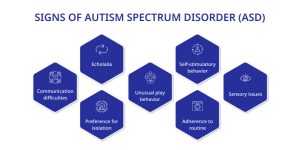Autism Spectrum Disorder (ASD) is a developmental neurological disorder that affects the brain’s normal functioning, leading to difficulties in social interaction and communication. The term “spectrum” is used to describe the wide variation in the type and severity of symptoms observed in individuals with ASD. Some children may be on the non-verbal end of the spectrum, communicating their needs through gestures or pointing. Others may be on the verbal end, repeating words or sentences, but still require varying degrees of assistance in social settings.

Few tell tale signs of ASD –
1. Communication difficulties: Is your child struggling to express their needs or communicate effectively with others?
2. Echolalia: Does your child repeat words or phrases over and over again?
3. Preference for isolation: Does your child prefer to play alone rather than with peers?
4. Unusual play behavior: Have you noticed your child engaging in atypical play behaviors, such as lining up toys?
5. Self-stimulatory behavior (stimming): Does your child engage in repetitive motor movements, such as hand-flapping or rocking?
6. Adherence to routine: Does your child become upset when certain tasks are not done in a particular way or at a specific time?
7. Sensory issues: Does your child exhibit hypersensitivity or hyposensitivity to certain sensory inputs, such as touch, sound, taste, or visual stimuli?
It’s important to note that every child with ASD is unique and will exhibit a range of symptoms and behaviors. Understanding your child’s specific needs and seeking professional support can greatly enhance their quality of life and help them reach their full potential.
Parents and caregivers of children with Autism Spectrum Disorder (ASD) can greatly benefit from seeking professional support such as speech therapists, occupational therapists, and behavioral therapists to help manage the symptoms of the disorder. However, it’s equally important for parents and caregivers to educate themselves about ASD and learn how to support their child’s unique needs. This may involve making adaptations in the home environment to accommodate the child’s needs and finding alternative ways to communicate their needs. Additionally, connecting with other families and support groups who have experience with ASD can provide valuable insight and guidance. By taking a holistic approach to supporting their child with ASD, parents, and caregivers can help their child thrive and reach their full potential